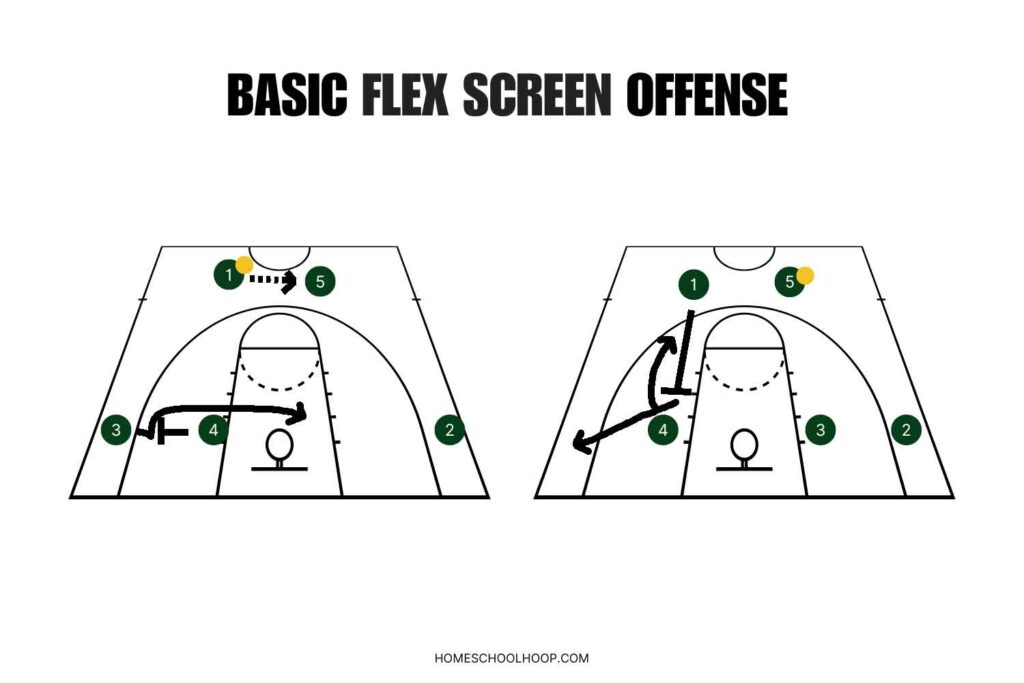We’ve covered how using screens in basketball is a smart way to make space for players to either pass the ball or take open shots. Today let’s dive into the specifics of the flex screen, a specific type of screen executed along the baseline and away from the ball. It’s an important part of the flex offense system and helps in getting open shots near the rim.
Key Takeaways:
- A flex screen in basketball happens when one player near the low block sets a screen for another player who is starting from the corner.
- The flex screen creates scoring opportunities close to the basket.
- The player moving off the flex screen (the cutter) can decide at the moment if they should complete the flex cut towards the basket or choose a flare cut to move away, based on how the defense plays the screen.
In this guide, we’ll dive into how to perform a flex screen correctly, the best times to use it, and what common mistakes to look out for.
Understanding the Flex Screen in Basketball
What is a Flex Screen?
The flex screen in basketball is an off-ball screen that is designed to get an offensive player open near the rim for a layup or dunk. One player sets a screen near the low block for their teammate in the corner, who comes off the screen and cuts toward the basket.
The diagram below shows an example of how the flex screen works. The screen leads the cutter into an open space within the paint.

Flex screens are usually used against man-to-man defense. Some consider the flex screen as a type of back screen because the screener sets up behind the defender for their teammate to cut to the rim.
It’s particularly effective when it’s executed with a great outside shooter as the cutter. With the defender sticking closer to the cutter, they’re more susceptible to getting caught up on the screen.
Learn more: How many dunks have there been in the WNBA?
Objectives of the Flex Screen
Teams use the flex screen to:
- Create open shots near the basket: The player coming off the screen usually finds open space close to the rim. With a quick and accurate pass, they’re in position for a high-percentage shot.
- Disrupt and wear out the defense: Even if the flare cutter isn’t open, the screening action makes the defense work harder. They’re also likely to get caught up later on as they try to keep up with the moving players.
While it can be incorporated into other offensive schemes, the flex screen is a key component of the flex offense. Started in the 1970s, the flex offense is a continuous-style system that involves a flex screen followed by a down screen.
The Mechanics of a Successful Flex Screen
When done right, the flex screen can turn a crowded court into a clear path to the basket. The screen itself takes two players: the screener and the cutter.
Setting Up the Flex Screen
To kick things off, the screener starts on the low block, while the cutter positions themself in the corner on the same side.
The flex screen action is usually triggered by a pass from the point guard to the wing that is on the opposite side of the screener. As soon as the wing catches the ball, the screener turns so they’re square to the cutter and gets set to create a barrier against the cutter’s defender.
Execution
With the screener set, ideally, both players stay ready to adapt and change their approach depending on how the defense responds to the play.
The cutter decides based on their defender’s position whether to:
- Execute the flex cut toward the basket as planned. If they’re open, they need to be ready to catch a pass and convert the assist.
- Flare cut away from the basket. A flare screen can be an effective counter if the defender anticipates the screen and shoots the gap too early.
After setting the screen, the screener can decide whether to:
- “Pop” out to receive a pass or
- Roll to the basket if their cutting teammate decides to flare.
If the flex screen is part of the flex offense, the screener has another teammate on the way to set a down screen in screen-the-screener action. The two screens together are particularly difficult to guard, which is why the action is even used at the NBA level.
Strategies for Implementing the Flex Screen
The flex screen is at the heart of the popular flex offense. Used by teams of all levels, the flex offense is a 4-out, 1-in continuity offense that involves flex screens quickly followed by down screens.
When executed well, flex screens within an offense are hard to guard. They lead to open layups or post-move opportunities. And when combined with the down screen in a flex offense, they can open up jump shots around the high post.
The flex screen in basketball is generally easy to learn, but there are ways to make it even more effective against defenses. Let’s look at some ways to make the flex screen harder to guard:
Teach players every position
The flex screen is generally part of a continuous flex offense, which means that players will be in every position at some point. It’s best if the players are interchangeable and comfortable doing all the skills necessary to pull it off: screening, cutting, passing, hitting layups, and shooting jumpers.
Cut hard
One challenge for teams that run offenses with the flex screen is that players start to go through the motions. If you’re the cutter, come off the screen hard, so your defense has to work to stay with you.
Get better at shooting
The flex screen and flex offense work best if every player can shoot well near the basket and from outside. If any player struggles, their defense can easily sag into the middle of the court and break up any opportunity a flex screen would create.
Learn to read the defense
Understanding when and how to exploit the defense when they read your flex screen will take your team’s offensive effectiveness to another level. One downside to regularly using the flex screen on offense is that it becomes predictable. The defense may start to read when the screens are coming, but they won’t be able to stop you if you’re able to throw in alternative actions.
Be patient
In a continuous offense with a flex screen, it often takes a couple of ball reversals before a player comes open. Rather than trying to force a thread-the-needle dime to a flex cutter who isn’t really open, be patient and reverse the ball until a better opportunity opens up.
Common Mistakes and Corrections
Even the best teams can slip up with the flex screen. Here are some common errors to catch and fix to make the screen more effective.
Drifting In: Anticipating the flex screen, the cutter in the corner may start to drift in toward the key too early. Stay wide so that your defender has to move out with you. This will put them in a better position to get screened and give you more space to come hard off the screen.
Poor Timing: When the screener and cutter don’t sync up, it’s too easy for the defense to adjust and navigate the screen. The screen action should take place as soon as the opposite-side wing catches the pass.
Incorrect Screening Positioning: The screener may set themselves too close or too far from the defender. Too far and the defense can easily get around the screen. Too close and they risk getting an illegal screen call.
Learn more: What is a moving screen?
Flex Screen in a Basic Offense
The basketball flex screen isn’t executed in a silo. It’s usually one piece to an offensive scheme. Here’s a look at how the flex screen fits into a basic basketball offense.
The offense begins with a 4-out, 1-in setup: two players at the top of the key, two low wings, and a single player in the low post.

- The offense begins with one player at the top of the key (1) passing it across the court to their teammate beside them (5).
- This pass prompts the player in the low post (4) to set a flex screen for the player on the wing (3), who cuts into the key looking to receive a pass.
- Immediately after the flex screen, the initial passer (1) sets a down screen for the flex screener (4), who pops to the top of the key. This is referred to as screen-the-screener action.
- (1) pops out to replace the low wing. The player who came off the flex screen (3) becomes the new player in the low post.
- If no player is open for a field goal attempt, the play repeats itself on the other side. (5) passes across the court to (4).
FAQs
What is a flex screen in basketball?
A flex screen is a type of off-ball screen. A player near the low post screens for a player in the corner. This frees the cutter up inside the key for an easy scoring opportunity. It’s a key play in the flex offense.
What is a flex cut in basketball?
A flex cut is a movement an offensive player makes off of a flex screen. The player starts at the corner and uses a screen set at the low post. They use it to cut toward the basket, hoping to receive a pass for an easy basket.
Does the flex offense work?
The flex offense can be very effective at all basketball levels, as long as it’s executed well. It relies on constant movement, screens, passes, and adjusting to the defense.
LET US KNOW
Today, you learned about the flex screen in basketball.
So we want to know: Do you have any tips for incorporating or executing a flex screen that we may have missed?
Share your insights in the comments.

